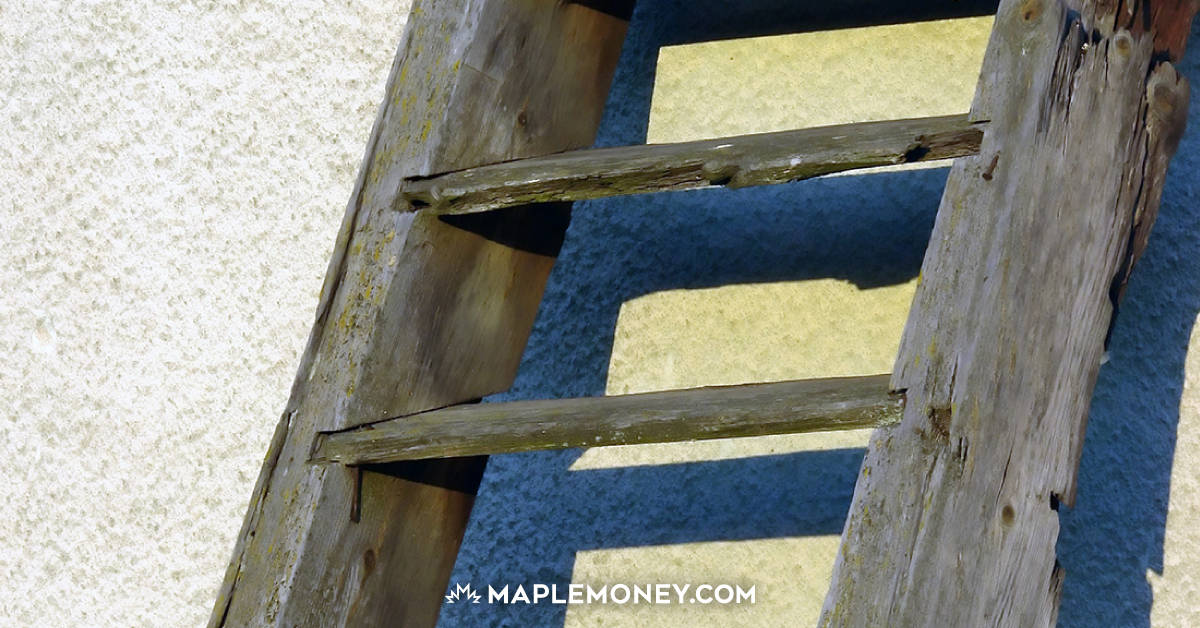How to Ladder GICs

You’ve got a lot of choices. If getting out of bed in the morning is a chore and you’re not smiling on a regular basis, try another choice.
~Steven D. Woodhull
I recently wrote about how CDIC protection makes GICs one of the safest investments. Whether you decide to devote a substantial chunk of your portfolio to GICs, or just a small portion, it pays to think about how you want to allocate your GIC investments. Which terms should you buy? How much should you put into each? A GIC ladder might be just what you’re looking for.
You can usually receive a better GIC rate than those offered by the big banks by consulting a deposit broker. It’s a good idea to make sure that the broker is registered with the RDBA (Registered Deposit Brokers Association). They can provide you with information about the services provided by deposit brokers in Canada. Generally, these services are free to you.
You may have noticed Fiscal Agents listed in the resources section here on Balance Junkie. They are a deposit broker. I don’t have any affiliation with them, nor have I used their services. I included their site here because they have some really neat tools there.
Alternatively, many online banks offer GIC rates that are much higher than the big Canadian banks. Most will offer them as TFSAs as well, although only a few online banks offer them under the RRSP umbrella. The convenience of banking online can be a big plus too, especially when it comes to dealing with GICs as they mature.
GIC Ladder: Step By Step
There are a few different ways to set up GIC ladders. I’m going to give you the most common one here.
Step One: Decide how much of your portfolio you want to allocate to GICs. (For this example, we’ll assume you have $25 000.)
Step Two: Divide the amount from step one by 5. ($25 000/5 = $5000)
Step Three: Set up 5 separate GICs with terms that range from 1 year to 5 years. (You will put $5000 each in a 1 year, 2 year, 3 year, 4 year, and 5 year GIC.)
Step Four: When each GIC matures, roll that money into a new 5 year GIC. (Each year, you will have a $5000 GIC (plus interest) maturing. Use that money to buy a new 5 year GIC.)
Ladder Variations
Roll into Consistent Terms
When each GIC matures, you would roll that money into the same term again rather than into a 5 year term. So if your 3 year GIC was maturing, you would buy another 3 year GIC. If you do the math on this, it usually doesn’t pay as well as the standard 5 year roll outlined above. That’s because interest rates on 5 year term investments tend to be higher. (In general, the longer the term, the higher the rate.)
Roll into a Different Investment
If you needed the money from the maturing GIC, you could spend it, or you could invest it anywhere else. You could buy stocks, ETFs, or bonds. Alternatively, you could roll it into a high interest savings account for safe keeping while you decide what you want to do with it.
Why Ladder Your GICs?
Interest rates can be very unpredictable. What seems like a low rate today could go lower – or not. Interest rates have been declining for about 2 decades now, and it seems like there’s no place to go but up. But you could have said that many times over the past decade or so. I have no idea how long interest rates will remain this low, or how quickly they might rise once they get started.
A GIC ladder can help spread out your interest rate risk by ensuring that you are always invested in a variety of terms. Renewing at 5 year terms ensures that you will always be investing at the highest CDIC-insured rate possible at the time. Remember that if you invest in a product with a term of more than 5 years, it will not qualify for CDIC insurance.
Your choice of GIC strategy should take into account your time horizon. If you are retired, you need to pay close attention to term maturities in order to make sure you will have access to the money when you need it. If you are very young, you can just keep rolling into 5 year terms without much worry about needing the money to live on.
If, however, you know you’ll need the money at a certain point in time to buy a car or put a down payment on a house, make sure you have enough money maturing when you need it.
Do you invest in GICs? What strategy do you use? Have you tried laddering?


Comments
This is a good GIC ladder strategy.
The ladder strategy I use is from
http://www.consumerismcommentary.com/2009/07/31/how-to-create-the-ultimate-certificate-of-deposit-cd-ladder/
A lot more effort in the beginning but gives a better liquidity option in that you are not locked in more than 3 months at a time. The effort comes from having to change the terms every 3 months.
Thanks Dave. That’s great information. For those who aren’t sure, CDs are just the U.S. equivalent of GICs. I would encourage everyone to look at this strategy. As Dave mentioned, it’s a little more high maintenance than the strategy outlined here, but if you’re a real GIC fan, it’s definitely worth your while.
Just a couple of things:
1) Take note of the footnotes in the article about the fact that 30-, 60-, and 90-day products often offer rates that are lower than a good high interest savings account. You may want to adjust your strategy accordingly.
2) One thing I didn’t (and should have) mentioned in the article is to keep your eyes peeled for special rate offers, especially under the TFSA and RRSP umbrellas. You can get some very good promotional rates a couple of times a year. Take advantage of that free money!
Thanks very much Dave. I’m going to look at this in more detail and see if this strategy fits for us. 🙂